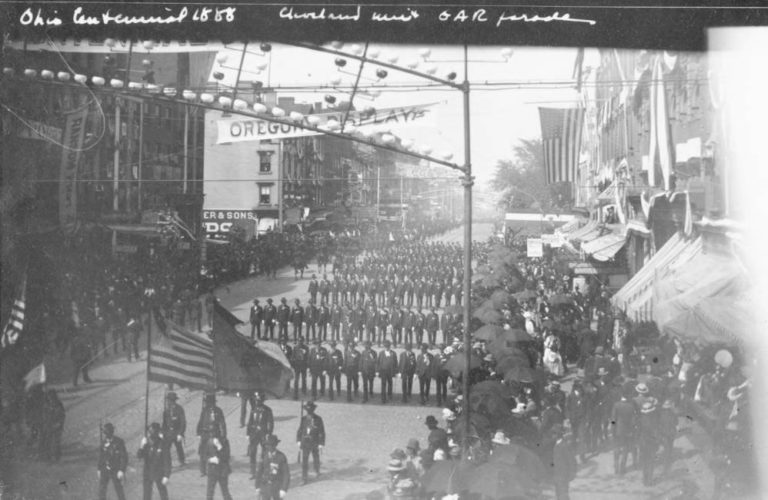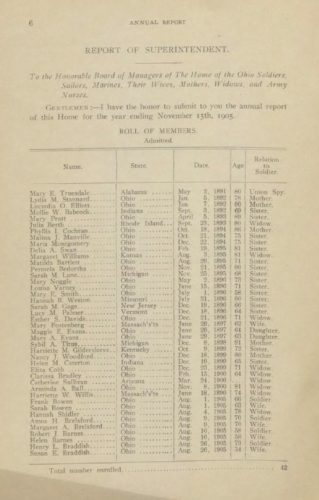The Madison Home: From a Grand Army to Ghosts

Today’s Friday the 13th post focuses on the Madison Seminary and Home. Although today it is known for its resident “ghosts” and haunted tours, for more than a century it was home to students and to the families of Ohio veterans.

The Madison Seminary was originally chartered in 1845 as an institute of higher education. Located in Madison, Ohio, near the Lake Erie coast, the original wood frame building was completed in 1847; a larger brick structure was added in 1859, providing boarding for up to 150 students during the school’s heyday. However, by the late 1800s, the increasing availability of public education decreased demand for a private seminary.
At the same time, growing attention was being given to survivors of the Civil War. The Grand Army of the Republic, a fraternal organization of Civil War veterans, was gaining lobbying power. President Benjamin Harrison, a Civil War veteran himself, promised pensions for veterans as part of his 1888 campaign platform. In 1891, the Madison Seminary buildings were purchased by the Ohio Women’s Relief Corps, an auxiliary of the Grand Army of the Republic, and renamed the Madison Home. The Home was remodeled and a new wing was added in order to house Civil War Army nurses as well as the wives, mothers, and sisters of soldiers. (The GAR also provided funds to establish the Ohio Soldiers’ and Sailors’ Orphans’ Home for the children of deceased Civil War soldiers.)
One of the Madison Home’s most notable residents was Elizabeth Stiles. Born and raised in East Ashtabula, she worked as a teacher and seamstress in Chicago for nine years before meeting and marrying Jacob Stiles. The couple moved to Kansas in the late 1850s, where Elizabeth continued to work as a teacher and was not shy about sharing her pro-Union views in the politically divided new state. One evening a group of strangers visited their house and killed Jacob on the spot. The men turned out to be Quantrill’s Raiders, pro-Confederate guerrillas that included young Jesse and Frank James.

Several months later Elizabeth was recruited by Abraham Lincoln to spy for the North. She sometimes disguised herself as a Southern grandmother looking for the wounded father of her “granddaughter” (actually Elizabeth’s thirteen-year-old daughter, Clara), and other times worked as a nurse in Confederate hospitals. Stiles was once arrested in Jefferson City, Missouri, under suspicion of being Union spy. By the time the interrogation was over, she had convinced the Confederate officer that she was actually a Rebel spy; before releasing her he gave her a horse and a better gun.
Elizabeth’s work as a spy ended in 1864 when her identity became known. She was cared for by her son until 1895, when she moved to the Madison Home. She lived there until her death in 1898.
By 1904, the Women’s Relief Corps could no longer afford to operate the building and donated it to the State of Ohio, which renamed it the Home of the Ohio Soldiers, Sailors, Marines, Their Wives, Mothers, Widows, and Army Nurses and ran it for several decades as a home for needy widows, mothers, and children of Ohio veterans. In 1962, management of the Home transferred to the Ohio Department of Mental Hygiene and Corrections, and the widows were either returned to their families or moved to nursing homes. Over the next two decades the site was home in turn to inmates from the Ohio Women’s Reformatory, mentally disabled women, psychiatric patients from the Cleveland State Hospital, and the Madison Township administrative offices. By the end of the twentieth century the Home’s fate was uncertain, despite being listed on the National Register of Historic Places. During this time, rumors started to circulate that the building was haunted. Today, the Madison Home is privately owned and used primarily for haunted tours.
Thank you to Stephanie Michaels, Research and Catalog Services Librarian at theState Library of Ohio, for this week’s post!



Leave a Reply
You must be logged in to post a comment.